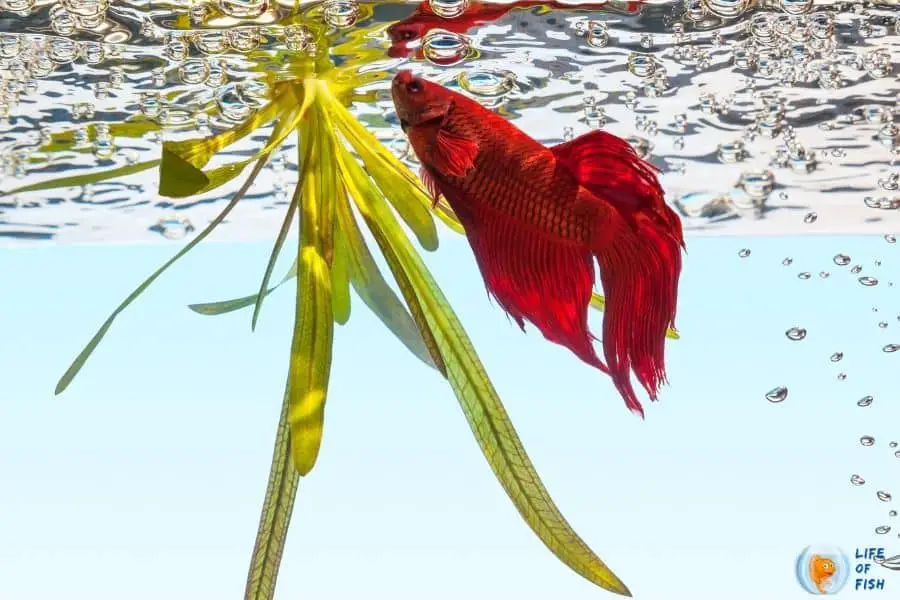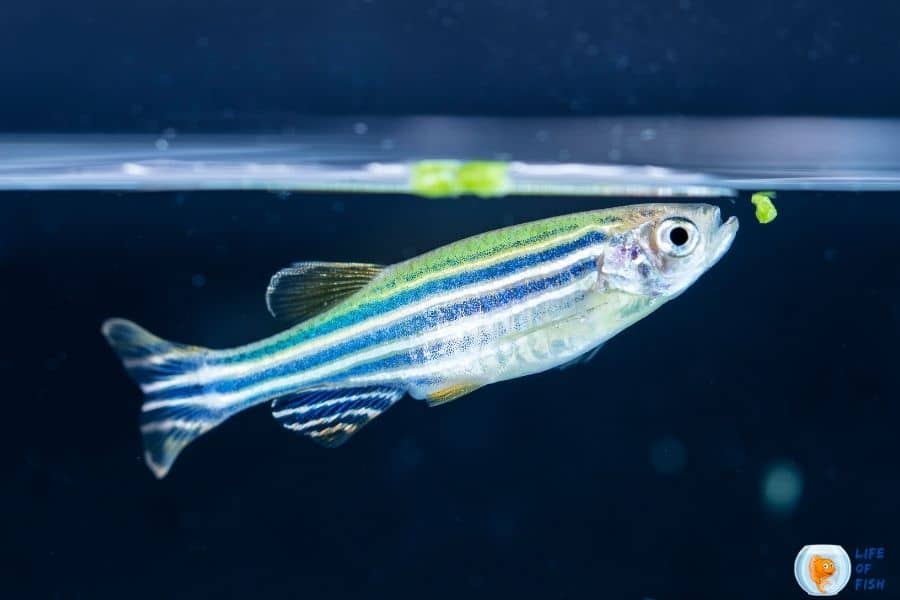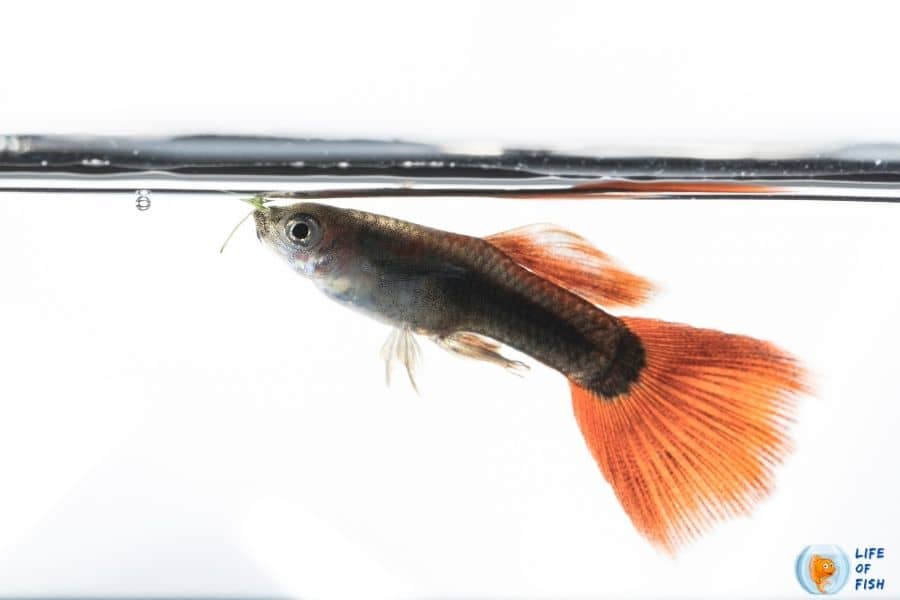As an aquarist, you may have at least one experience like this. I am sure, you may be confused about why fish at top of the tank after a water change. Keep reading! All your questions will resolve within a few minutes.

Why Are My Fish Swimming At The Top Of The Tank After The Water Change?
Jump To
- 1 Why Are My Fish Swimming At The Top Of The Tank After The Water Change?
- 2 Fish Died After Water Change: Why?
- 3 How To Save Dying Fish After Water Change?
- 4 How To Change The Water Without stressing or killing fish?
- 5 Should I Change The Water After A Fish Died
- 6 Aquarium Water Change Frequency
- 7 Related Questions
Regular Water changes are needed to clear the poor water quality of your aquarium. Otherwise, your fish will have to face a miserable death. But another important thing is when you change the water in the tank, you should do it the right way. If not, your fish have to face a quick death. All living creatures, including fish, can tolerate gradual changes in the environment. That is nature. Even though human beings have difficulty tolerating the sudden changes in their environment, they live. So, how do these little fish cope with that difference?
Changing the water leads to varying all water quality parameters of the tank. Especially when you change the large portion of water from your fish tank. So, the fish are difficult to face sudden changes in their water chemistry. Consequently, they will stress or even die. For instance, when replacing the water reduces the dissolved oxygen levels of the water. But, the tank topmost water layer always contacts the atmosphere and it includes a relatively high dissolved oxygen levels than middle and bottom water columns. So, due to oxygen deficiency in the middle and bottom water columns of a tank, fish is difficult to breathe. Then they tend to come top of the tank.
Fish Died After Water Change: Why?
We cannot name only one reason that causes what kill fish after water changes. Because water changes may change each water quality parameter. Accordingly, it affects the water temperature, pH level, and water hardness. Therefore, these changes shock your fish. You would think that fish can be a shock or stress only during a large water change.
But it is not true. Fish can be shocked or stressed even the small water change if you change the water after a long time. So, multiple things can be gone wrong. Therefore, you should consider all these things when you change the water in the aquarium. Otherwise, the single wrong that you do will lead to affect your fish badly.
High Nitrate Level Or Water-Quality Changes
As we know, when nitrate level is high, it can be toxic to the fish. But if you change the water, nitrate levels will drop suddenly. It will give an osmotic shock to fish. So, what is this osmotic shock? And how it connects with the nitrate level of the water? Let’s find the answers to these two questions. Simply nitrates (NO3–) are ions. Normally, fish can tolerate and adapt to gradual changes of ions and ionic compounds in the water. For instance, marine water fish adapt to gradual changes in the salt in their environment.
Whether fish are in freshwater or marine water, they need osmoregulation to survive in their particular environment. So, osmotic stress can be defined as the failure of the fish body to regulate the absorption of ionic compounds. Consequently, this condition leads to either release or absorb too much fluid. So, changing the water suddenly decreases the water’s nitrates level, leading to osmotic stress for fish.
For instance, when osmotic stress comes with a water change, freshwater fish tends to hold too much fluid. As a result of this, their organs swell. This condition can be named Dropsy. Then these swollen organs may put pressure on the swim bladder of the fish. That is why fish are swimming upside down or sideways when changing the water. So, how do we aware of this? After changing the water, you can use a liquid test kit to check the nitrate level. On the other hand, you can protect them from osmotic shock by changing around 10% water at once.

Temperature Differences
Water temperature is a major requirement for fish to live healthily. So, most probably, new water does not match with the temperature of the existing water in the aquarium. So, it also leads to ill or dying fish after changing the water. A fish’s body is not like the human body. It is coldblooded. So, fish cannot regulate body temperature with the external environment. When you change the aquarium water with new cold water, it will lead fish into thermal shock.
So, how do we identify when the fish go into thermal shock? Generally, this type of fish does not remain active. Further, they lose their bright color quickly. Also, these fish can be quick death after doing a water change. You can prevent this by doing the water change with the heated beforehand water. But do not tend to increase the temperature too fast when your fish is in the tank. It will again shock your fish.
Low Oxygen levels
Generally, most aquariums are equipped with an air blower or filter. Thus, this water is in a well-oxygenated state. But when you are replacing water, the new water does not have enough dissolved oxygen. So, in that kind of situation, fish may difficult to breathe. That’s why they try to go upper water column of the tank. Hence, increase the oxygen level of the tank by using the below simple ways.
- Use an air pump to oxygenate the water
- You can pour water at some height
- Use ice cubes to regulate water temperature and increase oxygen dissolving ability
- Stir the tank water for 5- 10 minutes
- Take a straw, saline pipe, or another valve and oxygenate the water using exhaling air from the mouth
Direct Tap Water
Tap water comes with chlorine or chloramine. Both of these are dangerous to fish. If you direct add tap water without adding de-chlorinator, it can cause to destroy your whole aquarium within a short time. Typically, a good de-chlorinator takes about 5 minutes to neutralize the chlorine in the water. There is another damage from chlorine water. But many hobbyists do not much care about it. It is, when you add tap water directly into the aquarium, chlorines have the ability to wipe out all beneficial bacteria. It will badly affect the nitrogen cycle of the tank.
Vacuum Substrate Completely
When we hear the word “bacteria,” the worst feeling may come to our mind. But all bacteria do not harm. There are several beneficial bacteria in your aquarium fish. Most of them live on the porous surface of the tank. Not only that, this porous surface is the ideal breeding place for beneficial bacteria. So, when you clean or vacuum the substrate completely during the water change, it causes remove a large chunk of beneficial bacteria from your fish tank.
However, these beneficial bacteria need to maintain the nitrogen cycle of your fish tank. Simply the nitrate cycle can be defined as the process of converting ammonia into less harmful substances. Cleaning substrate entirely may lead to hinder the nitrogen cycle in your aquarium. This can be stressed your fish.
Complete Change Of Filter Media
As I mentioned above, there are beneficial bacteria in our aquarium. The tank filter media is another place besides the substrate where a lot of beneficial bacteria live. Thus, a complete change of the filter media is more dangerous. Because when you change the filter media simultaneously, you will remove the large portion of beneficial bacteria in your aquarium.
It causes to increase the nitrogen and ammonia levels of the fish tank quickly. Unfortunately, all your tank fish can be dead because of this reason. Do not panic; you can protect your fish from this. What you should do is rinse the filter media by using de-chlorinated tank water. But keep in mind, do not vacuum the substrate completely. It is better to vacuum the substrate for less than 30% per session.
Sudden Change Of Water Hardness
Fishes are unable to tolerate the hardness of the water. So, if you directly add new water to your tank without treating it, it negatively impacts your fish. So, before adding the water, you should be aware of the hardness level that your fish can tolerate and soften the water before you add it.

How To Save Dying Fish After Water Change?
You can try out these steps to save your dying fish after the water change.
Step 1: Firstly, you should immediately add the filter and treat the aquarium water
Step 2: Turn on the aquarium heater and give the optimum temperature
Step 3: Add one tablespoon of salt per 3 gallons of water. When you are done with treating the water, you should check other fish whether they also show the symptoms or not.
Step 4: Feed the fish with veggies and low protein foods. Then wait for few minutes. If there is any improvement, you have to go to commercial fish medicines. But if you notice that the fish is struggling more than early, it is time to say goodbye to your fish.
Special Note: Suppose you could find out that your fish are shocked and dying due to ammonia and nitrogen poisoning. At this time, you can add bacteria-starting supplements into the water. It takes some time to be effective, but it will help fish to deal with this shock. I recommend the Tetra SafeStart Plus, and you can find out it on Amazon and Chewy.
How To Change The Water Without stressing or killing fish?
You can do this in several steps. But before that, you have to collect a few things.
- A bucket or container ( Use stainless steel or plastic basket. do not use a basket that includes copper)
- A water de-chlorinator
- A small heater that suits your aquarium
Step 1: Fill the bucket with the required amount of water
Step 2: If you use tap water, you should check the quality of it
Step 3: Set the aquarium heater and heat the new water until matching the temperature of the aquarium
Step 4: Add de-chlorinate to the water. Then give it 5 to 10 minutes to process.
Step 5: Stir up the water in the container for around one or two minutes. It will allow gaseous exchange between the atmospheric air and water
Step 6: It will be better to change 10% of water per session. If you want to change the more, wait one or two hours for the second session.
Step 7: Monitor and maintain the ideal water quality after replacing the water
Should I Change The Water After A Fish Died
Yes. It is better to change the water. First of all, you should remove the dead fish as soon as you find it. Because the dead fish body starts to decompose and it causes to pollute the water. Consequently, it can be affected to other fish badly. Because when decomposing the dead fish body, it will release more ammonia and nitrates.
Therefore, it is better to go for water changes. Here you should test the water and get an idea about ammonia and nitrate levels. Then decide the percentage of water that you should change to settle the ammonia and nitrate levels. Ammonia level should be below 0.25 ppm. It is better to change 10% water every hour because it will help avoid stress due to water change.
Aquarium Water Change Frequency
It is recommended to change to 10-15% water per week. But if your aquarium is heavily stocked, it is better to go 25% water change for each week.

Related Questions
Guppies Died After Water Change
Guppies are also shocked due to changes in their environment. So, if the fish cannot tolerate the change, they will die. Moreover, there are several reasons to die guppies after water changes.
- Guppies are tiny animals. So, they have a susceptible life
- Change the water temperature.
Guppies are tropical fish, and they can not tolerate cold temperatures. The most aquarium has heaters. But when we add new water to the tank, those are cold.
- The sudden change in other water quality parameters such as pH level and water hardness
- Raising the ammonia and nitrate level of the tank water can be affected guppies badly
Betta Fish Sick After Water Change
Performing a huge water change in your betta fish tank will directly affect the water parameters. Consequently, it will shock your betta fish. On the other hand, a large percentage of water change cause to wipe out the beneficial bacteria from the tank. As a result, it increases the ammonia and nitrate level of the tank water. It may directly affect betta fish’s long and beautiful fins. So, like this situation, how does your betta fish save its life.
Read More: Aquarium Lava Rock | Rock Solid Facts About Benefits And Drawbacks |
